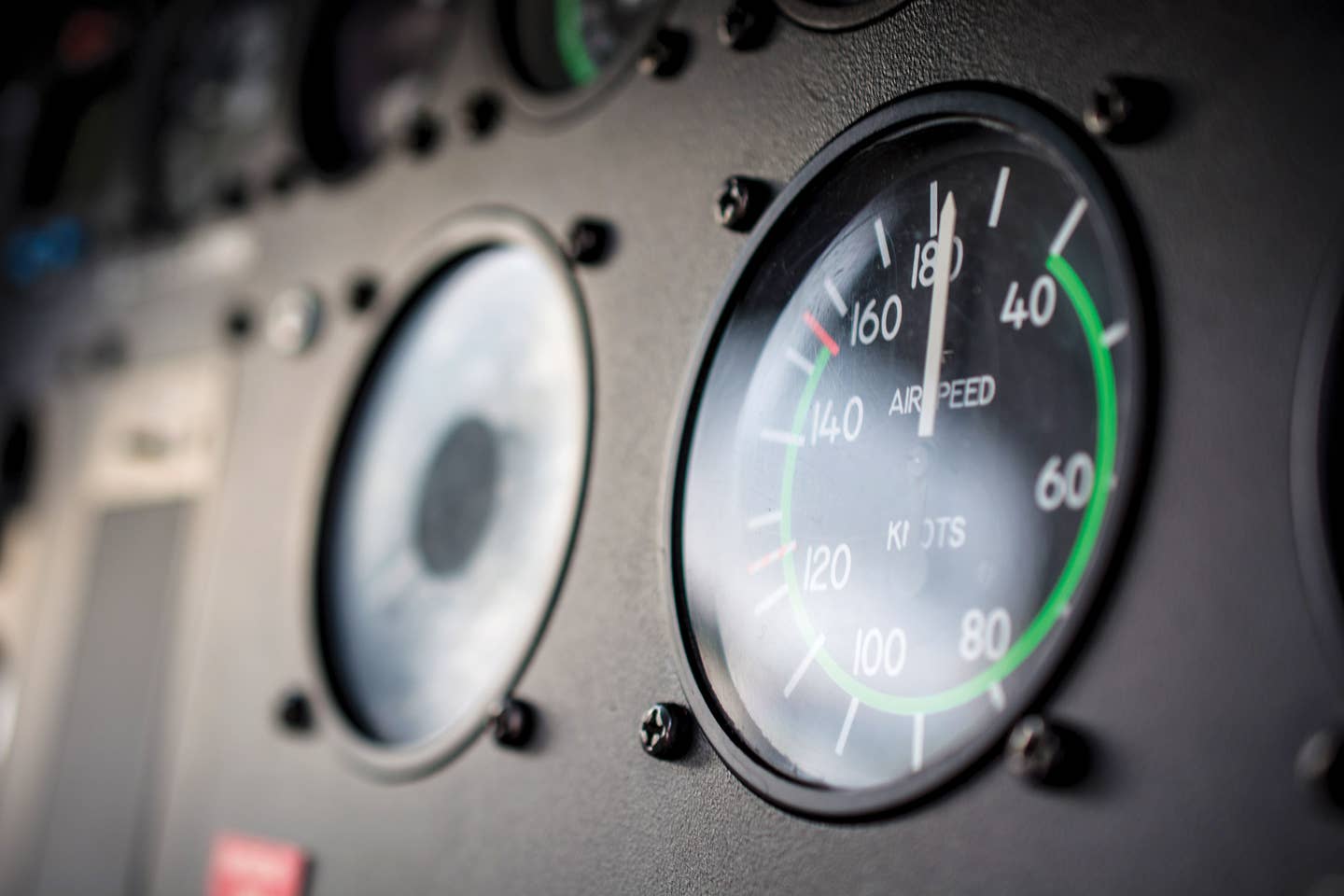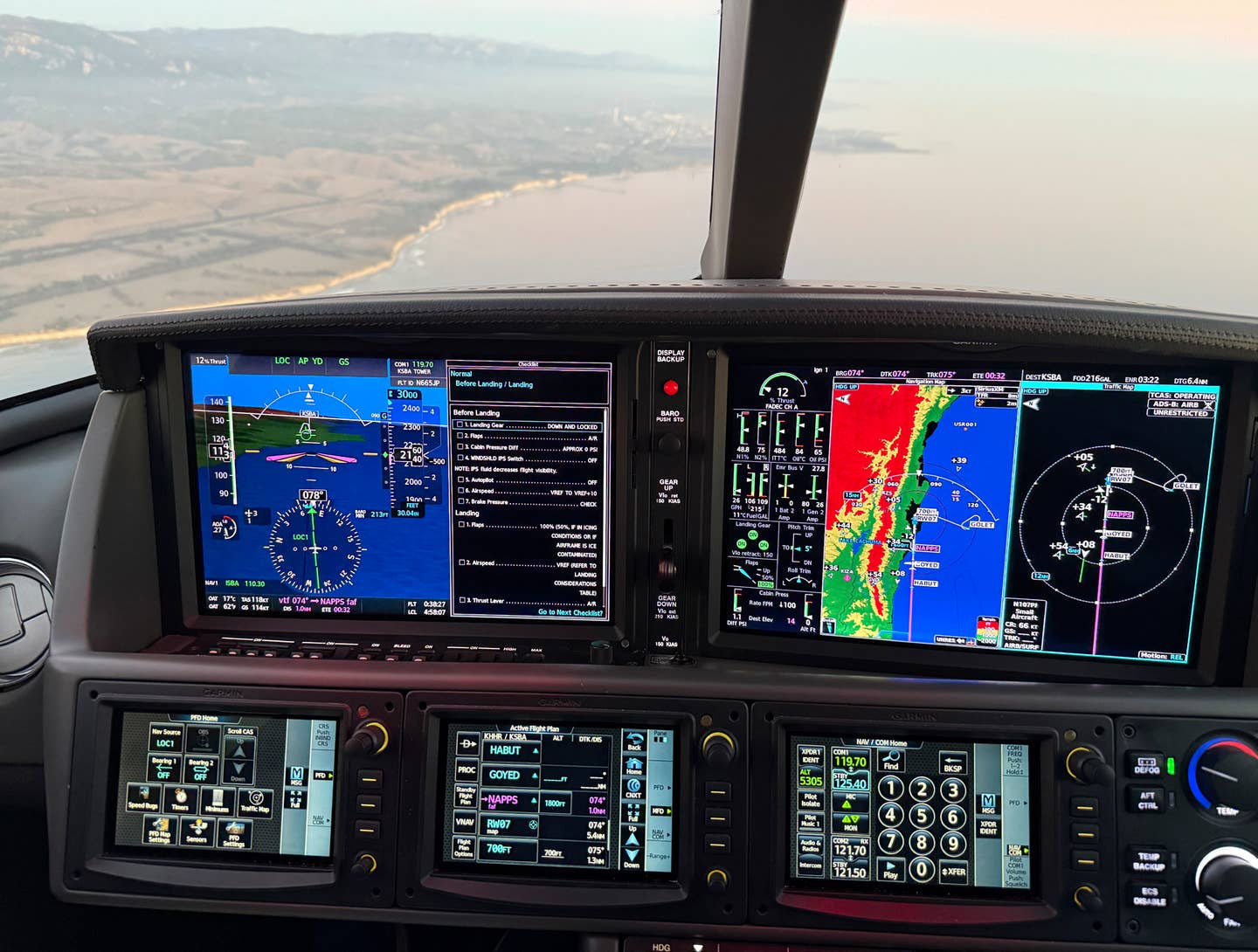
Near a stall, the airspeed indicator is a mediocre substitute for angle of attack. istock/Benjamin Schaefer
The airspeed indicator may be the oldest and most fundamental of the flight instruments, but it is also the one least suited to its job, which is primarily not to tell us how fast we are going but rather where we are in the flight envelope. It is pleasant to know, as we cruise along, that we are indicating 137 knots; but the airspeed indicator is most important at low speeds, close to the stall, and it is there that it is most likely to play us false.
We use airspeed in two ways. As a gauge of dynamic pressure—that is, of the force exerted by moving air on the airplane—it tells us during the takeoff roll when to rotate. Dynamic pressure is also the defining parameter for gear and flap operating speeds, single-engine minimum control speed and never-exceed speed—although the last is actually a true airspeed based on flutter considerations.
Many of the characteristic speeds of an airplane—stalling, maneuvering, turbulence penetration, glide, best rate or angle of climb—are proxies for certain angles of attack. As proxies, however, they are unreliable. They fail to factor in what I will temporarily call, without attempting to pronounce it aloud, the Gweight. Gweight is the weight of the airplane multiplied by the G loading, and at any given moment, it is equal to the lifting force being produced by the wing. A 3,000-pound airplane in a 60-degree banked turn must pull 2 Gs to maintain altitude; its Gweight is 6,000 pounds. If a 1-G gust strikes the airplane during the turn, its Gweight rises to 9,000 pounds.
It’s difficult for us to relate airspeed to the Gweight because airspeed is proportional to Gweight’s square root. Suppose that, our 3,000-pound airplane has a clean stalling speed of 70 kias, its best rate-of-climb speed is 100 kias, and its maneuvering speed is 125. At the end of a flight, with only the pilot and minimal fuel aboard, its Gweight is only 2,000 pounds; now it stalls at 57 kias and climbs at 82. Its maneuvering speed is down to 100. In a 60-degree bank at gross weight, however, its stalling speed is 100—throw in that gust, and it becomes 121.
In other words, depending on circumstances, the stalling speed, that life-preserving number, can have almost any value.
Angle of attack, on the other hand, is for all practical purposes directly proportional to Gweight. All airplanes reach maximum lift at some angle of attack, usually 15 to 18 degrees above the zero-lift angle; they make half that lift at half that angle, a quarter at a quarter and so on. The characteristic speeds of the airplane, because they correspond to certain angles of attack, also correspond to certain fractions of the maximum available lift.
Suppose that instead of an airspeed indicator, we have an instrument that displays percent of available wing lift on a scale of zero to 100, with 100 representing the maximum lift available, just before the stall. This lift gauge would be similar to an angle of attack indicator, but it would cover a wider range of angles of attack than usual. Angle of attack indicators tend to focus on the low-speed range; at high speeds, changes in angle of attack are small, hard to measure and of little practical importance. But I think angle of attack information would be useful at least as far as the maneuvering speed.
Although I and my fellow aviation writers have been singing the praises of angle of attack indicators for ages—I have been flying with, and relying on, a Safe Flight SC-150 for 40 years—it was not until recently that a number of them appeared on the market. But they are still small, auxiliary-looking instruments, advertised as providing pilots with an extra margin of safety. That is putting the cart before the horse. A direct indication of the fraction of available lift being used ought to be primary for operations at airspeeds at or below the best rate-of-climb speed.
Unfortunately, pilots are indoctrinated from the very start of their training with a religious regard for the airspeed indicator. We become conditioned—perhaps brainwashed would be a more appropriate word—to think of our flight state in terms of speed, not angle of attack or its equivalent, lift fraction. The presentation of angle of attack in an ancillary role merely reinforces that tendency.
The lift gauge, as I envision it, would be central and conspicuous. It would have markings at 50 (best rate of climb) and 60 (approach speed 1.3 V) and an ominous-looking, orange-grading-to-red band between 75 and 100. Because Gweight is proportional to angle of attack, what we now call “maneuvering speed” would become, for a normal-category airplane, a mark at 26 (because the limit load factor, 3.8, times 26 equals 100). Whenever the moving index was between that mark and 100, you would have the protection provided by maneuvering speed on the airspeed indicator. Below 26 would be the yellow arc.
Read More by Peter Garrison: Technicalities
Each type of airplane has its own characteristic speeds and its own set of airspeed-indicator markings. The lift gauge, however, would conceal those differences. It would be exactly the same in all airplanes, regardless of speed range or wing loading, and would be used in the same way. It would automatically account for varying weights, G loadings and flap configurations. Unlike an airspeed indicator, it would be responsive to gusts: A positive gust would make the index jump upward, and if you saw the index repeatedly getting close to 100, you would know to lower the nose. This would represent an improvement over the current “10 knots for grandma” system for approaches in turbulence.
Airspeed indicators cannot be banished altogether. Let commerce flourish. The airspeed indicator supplies the dynamic-pressure-related speeds, provides a backup in case of failure of the lift indicator, enables pilots to comply with ATC speed instructions and in some cases, is an aid to boasting.
I leave the physical implementation of this device to someone more ingenious than I. It is unlikely that lift fraction could be sensed directly, with conveniently linear variation, by measuring either pressures or flow directions; that difficulty has always been an obstacle to simple, cheap AOA instrumentation. Instead, some AOA-related variation in some parameter or other would be detected, and a microprocessor would be trained to translate it, for each airplane type, into fractions of available lift. This would then be conspicuously displayed—either on a gauge or as a portion of an electronic display—in such a way that it overshadows the airspeed indicator. In this case, size really does matter. A little brute force will be required to wean pilots from their airspeed indicators and train them to rely on a lift gauge instead.
The sainted author of the foundational how-to-fly book Stick and Rudder, Wolfgang Langewiesche, always insisted that when we fly, we are flying a wing. Wings don’t think about speed, they think about lift, and we ought to start doing the same.

Sign-up for newsletters & special offers!
Get the latest FLYING stories & special offers delivered directly to your inbox






